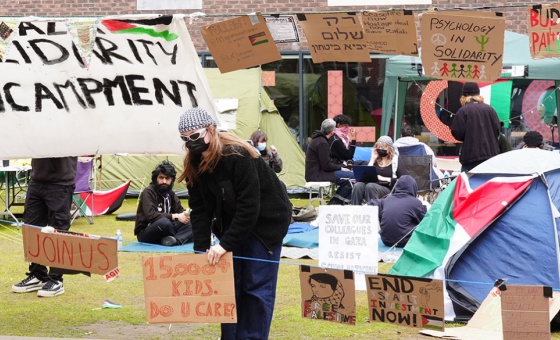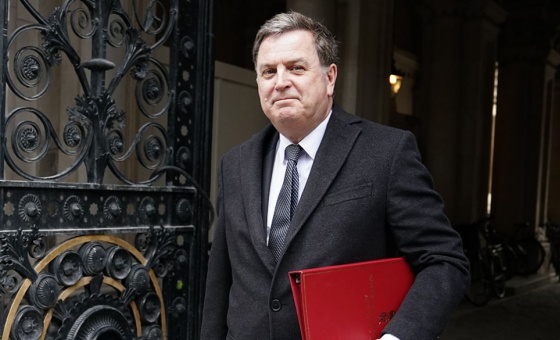This is the last article you can read this month
You can read more article this month
You can read more articles this month
Sorry your limit is up for this month
Reset on:
Please help support the Morning Star by subscribing here
WE ARE often reminded in the mainstream world that Britain has had “a special relationship” with the US since WWII. We are less frequently reminded that over the same period the US and Britain have shared a special relationship with aggressive war.
During their wretched alliance, the US, much more powerful economically and militarily than Britain, has mostly been the primary aggressor, with Britain in close support.
The first huge example since 1945 of a US-driven war was that in Korea, begun in late June 1950 and ending with an armistice — but not a final peace settlement — on July 27 1953.
One leading history — Korea: The Unknown War — appeared in 1988, and was linked to a Thames TV documentary series. The authors were Jon Halliday and Bruce Cuming, the latter a US historian who also wrote a broader and highly respected 1997 history Korea’s Place in the Sun.
However unknown the Korean war continues to be, its realities are mind-numbing. The history presented by Halliday and Cuming adds up the horrendous death toll of at least 3 million Koreans (from a population of around 30 million), an estimated one million Chinese soldiers, and almost 55,000 American. And there were casualties from other countries too, including 686 British soldier deaths.
But how did that happen, following the conclusion of a world war in which at least 60 million human lives (including the not always included Chinese contribution) were lost?
Eric Hobsbawm summarised it with stark succinctness in Age of Extremes: “Shaken by the communist victory in China, the US and its allies (disguised as the United Nations) intervened in Korea … to prevent the communist regime in the North of that divided country from spreading to the South. The result was a draw.”
Korea, north and south, east and west, had been unified and independent for more than a 1,000 years before it was occupied by Japan after the 1904-5 Japan-Russia conflict, and annexed as a colony in 1910.
As August 1945 began, Japan’s colonial regime was still in charge. On August 8, the Soviet Union, having long agreed with its Western allies to enter the war against Japan, did so, entering Korea (as well as Manchuria). Two or three days later, two US colonels, told to draw a convenient dividing line between north and south, ran it along the 38th parallel north of capital Seoul. Substantial US forces landed in the south on September 8, and more came later.
Korea remained one country, and on September 6, independently of intervening forces, a Korean People’s Republic in the capital, backed by widespread “people’s committees” from the localities, was formed. It did not last long.
The country was populated largely by poor peasants and a tiny minority of rich landlords, the latter but not the former having benefited during Japanese rule, and having collaborated much with the colonial master.
In the south, the US firmly supported the landowners, and the reactionary, if anti-Japanese, political leader septuagenarian Syngman Rhee, brought in from long residence in US.
In December 1945 the US enhanced its control by beginning to form an army to defend the 38th parallel line, with security police to subdue dissent.
Massive uprisings of people in the south seeking radical change were in 1948 violently suppressed.
In the north, while Soviet advisers reinforced the land reform sought by the mass of peasants, facilitating the dispossession of landlords without compensation, a government was soon established under communist Kim Il Sung, who had been a guerilla leader fighting Japanese forces in Manchuria.
Says Cuming: “Landlords were allowed to flee south or to work small plots of land.” Nevertheless, political dissent was ruled out, while as 1948 ended, Soviet occupation forces were withdrawn.
Subsequently, North Korea’s link with China (against the backdrop that many Koreans had fought with the Chinese communist army against the Japanese) became stronger.
One thing was clear: both the communist regime in the North and the anti-communist regime in the South wanted a united country.
Border fighting took place during much of 1949, and before civil war erupted fully in June 1950, Syngman Rhee repeatedly expressed a desire to take over the north militarily.
The jury is out, Cuming suggests, as to whether the final trigger for the war was pulled by the southern or the northern regime, given the latter’s claim of shelling and an attack on the western Ongjin peninsula on June 23 by southern forces.
The North’s attack southwards across the parallel, reactive or not, on June 25 was initially successful, achieving the capture of Seoul within a few days.
A giant untruth — peddled as an unanswerable justification for Western intervention and for which there was no evidence — was that the North was acting on Moscow’s orders — part and parcel of a non-existent Soviet plan to impose communism on the world.
A reference by the US to the UN on June 25 produced a resolution calling on North Korea’s forces to withdraw, and was followed by a security council resolution two days later.
The Soviet delegate, Yakov Malik, had walked out on January 13 in protest against a refusal to seat China’s Beijing communist government in place of the Nationalist leadership defeated and quartered in Taiwan.
This US-sponsored security council resolution (which the Soviet Union as a permanent member was entitled to veto), called upon member nations to “render such assistance” to the southern government “as may be necessary to repel the armed attack and to restore international peace and security to the area.”
It was carried in the Soviet delegate’s absence without any direct approach to the Kim Il Sung government.
In hindsight, the North’s drive South looks like a political as well as a military mistake, given the powerful US backing for the Rhee regime (funding most of the regime’s budget).
A defensive strategy may have been wiser.
But the “UN” call was for outside nations to turn what was in essence a civil war, Koreans against Koreans, into an international conflict.
Two Labour backbench MPs, SO Davies and Emrys Hughes (son-in-law of Keir Hardie) honourably stood alone in calling on July 5 for Britain to withdraw from participation in the war. Hughes kept up the challenge the war’s continuance in the house, asking, in March 1952, if British taxpayers’ money was being spent on the “napalm bomb.”
The North’s incursion was halted in August, and its forces were soon pushed back across the parallel. But this retreat was soon accompanied by the introduction of Chinese troops alongside North Korean, and a retreat back of US and southern forces.
On November 30 1950, at a press conference, president Harry Truman did not exclude the possible use of atomic bombs. He wrote a few days later: “… it looks like World War III is here …”
Fighting continued, but with the line dividing southern and northern forces settling along the 38th parallel.
Although Truman came to the edge of authorising the use of nuclear weapons, in the event US forces made do with demonising the enemy as “gooks,” with routine atrocities, with extensive use of napalm, the breaching of major dams which flooded North Korean valleys, and a meticulous bombing campaign which, Cuming wrote, “levelled Korea and killed millions,” leaving hardly a building standing.
What was left of the population “survived in caves, the North Koreans creating an entire life underground, in complexes of dwellings, schools, hospitals and factories.”
Britain’s Labour government, headed by Clement Attlee, supported the US, sending ships as well as troops, increasing military expenditure, while balking at the possible use of nuclear weaponry.
The Winston Churchill government which followed from 1951 continued to back Washington’s relentless destructiveness.
Today, of course, a North Korean communist government continues in place, and ready to defend itself with its own nuclear weapons.
Its stance cannot be understood without awareness of the terrible conflict which took place so long ago, and without awareness of repeated US-aggression since against regimes refusing US dominance.
The special relationship which the US and Britain share with aggressive war goes on.
John Ellison is the author of the new book World War II: A People’s War.










